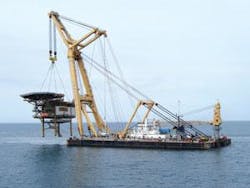Sheerleg barge performs swift, cost-effective platform removal
Jeremy Beckman
Editor, Europe
Dutch contractor Smit Marine Projects has completed the company’s first platform removal in the North Sea. During the summer season, the 1,600-metric ton sheerlegTaklift 4was mobilized to remove the K10-V platform, situated 80 mi offshore the port of IJmuiden. The topsides and jacket of the steel platform were then transported in the barge’s slings to IJmuiden and Rotterdam. The deck will be reused for a new development, while the jacket has been scrapped.
K10-V operator Wintershall awarded Smit the contract last December, on the basis of a competitive price and a novel turnkey solution. Use of theTaklift 4rendered deployment of a heavy lift derrick barge unnecessary.
Smit has undertaken many North Sea heavy lifts in the past, but not for the purpose of platform decommissioning, although it has removed offshore structures in other areas of the world, such as the GoM.
K10-V was in a clean condition when the removal project began, all potential pollutants having been removed. The platform’s topsides weighed 800 metric tons, and the jacket 700 metric tons. The accommodation crane bargeTaklift 1was mobilized for preparatory work, which involved securing all loose equipment, erection of scaffolding around the legs (at the cutting positions), inspection of all lifting points, and rigging of the sheerlegs.
Cutting operations lasted just four hours, and were completed prior to arrival of the sheerlegs. TheTaklift 4 then connected up and transported the topsides in the slings to IJmuiden. The 69-mi voyage took just over eight hours. Weather conditions were excellent, with significant wave heights of less than 0.5 m. On arrival, the jacket was placed on a prepared area on the quayside.
Subsequently, the vessel returned to the offshore site to complete the second phase. Following preparation of the jacket, the scaffolding was removed and stations drilled for the lifting pins, which were then installed. These pins were located at positions that distributed stresses throughout the structure during the lift and transport.
All subsea work was diverless, including cutting of the four piles 6 m below the seabed. A specially designed “airlift” was employed during the subsea operation. Each pile plug was removed and a cutting tool inserted. The rotating abrasive tool cut away each leg, with the sheerlegs connecting up to the lifting pins. The 25 m x 25 m x 48 m high jacket was then lifted to a point 17 m below the surface and transported in the slings in a semi-submerged mode to the disposal yard at Ridderkerk, near Rotterdam.
In the final phase, the project team carried out an ROV survey of the site to ensure that the surrounding seabed was free of debris. The final task called for removal of two 30/36-in. diameter conductor piles. An internal cutting tool was applied, and then the piles were recovered by the sheerlegs.
Smit sees platform decommissioning/removal as having significant growth potential, though not to the degree suggested by some industry commentators in recent years. The company is focusing on platform removal in the shallow waters of the southern North Sea, where its fleet of heavy lift vessels can accommodate smaller structures. The contractor is aiming to bid for one or two projects of K10-V-type yearly.
In basing its turnkey removal methods around sheerlegs, the company says it offers a cost-effective alternative to large crane vessels and transport barges, even though its solution is more weather-sensitive than other options.•




